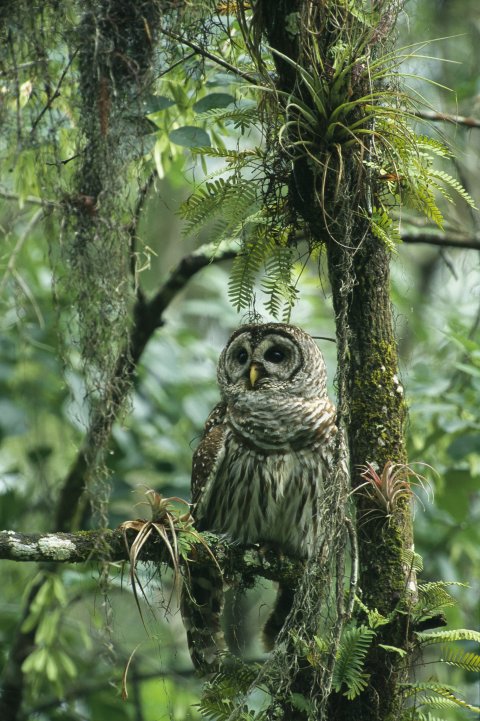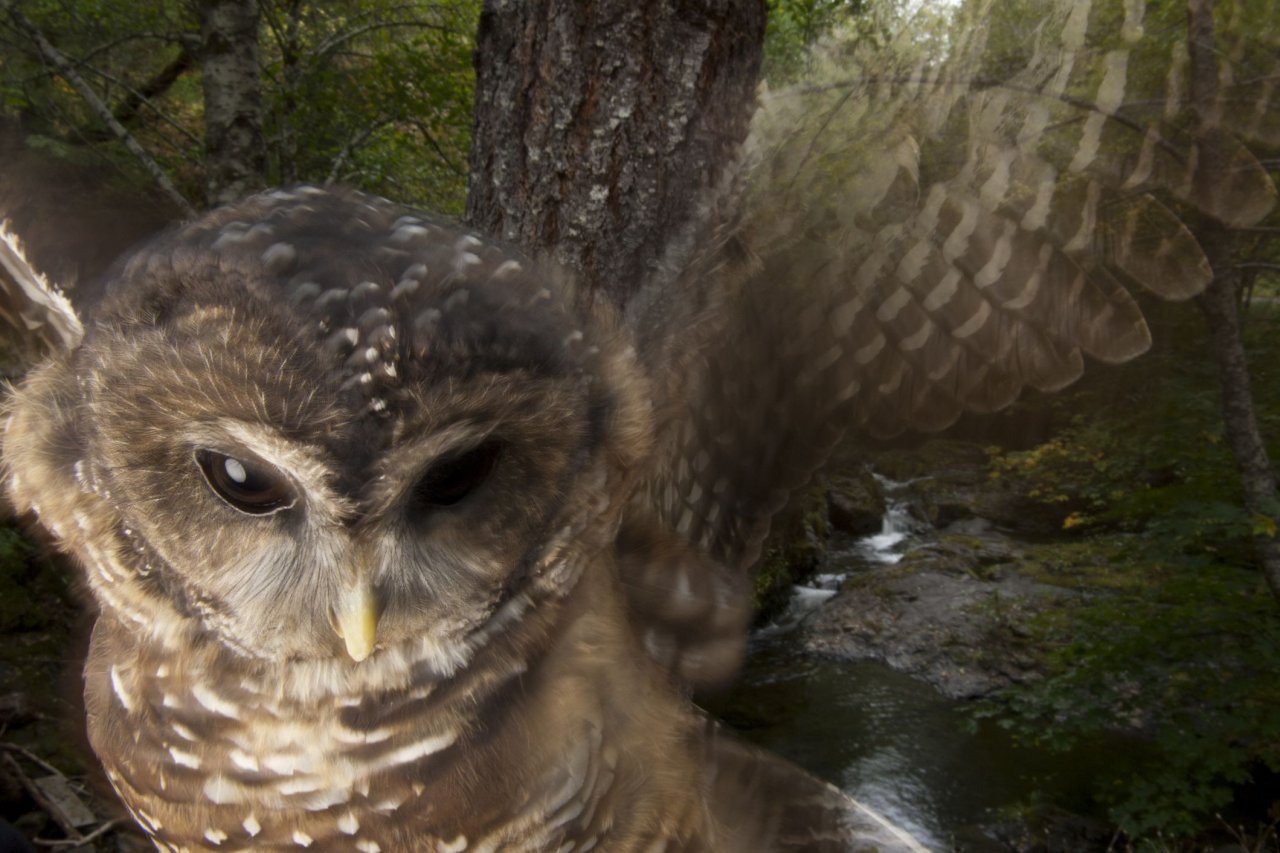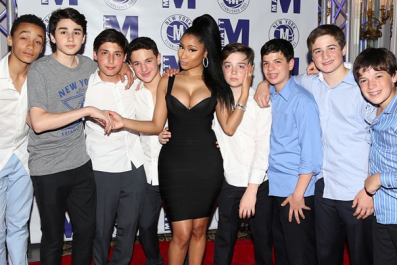Robin Bown still remembers the first time she saw a barred owl, sometime in the 1970s, when she was a high school student living near Washington, D.C. "There was an owl that would sit in a cavity in a tree and watch people on the C&O Canal towpath," she says. The rare chance to see an owl up close, to look it in the eye and have the wild bird meet her gaze, stuck with her. Today, Bown, a biologist with the U.S. Fish and Wildlife Service in Portland, Oregon, is in charge of a team writing a plan to shoot roughly 3,600 of the birds in Oregon, Washington and California.
The plan is part of an experiment to test whether competition from barred owls is driving down populations of the northern spotted owl, a threatened species. Will removing barred owls help spotted owls recover? If the strategy doesn't work, say Bown and other biologists, the spotted owl is probably doomed, at least in large parts of its range. But the alternative might be even more difficult to contemplate: What if it does work?
"This is unfortunately a classic no-win situation," says Bob Sallinger, conservation director of the Portland Audubon Society. "The idea of killing thousands and thousands of these beautiful birds is unacceptable to many, many people. At the same time, having a species like the spotted owl go extinct is also unacceptable."
FEATHERY BODY SLAMS
For millennia, barred owls kept to the eastern half of North America. Then, sometime around 1900, scientists believe, they pushed beyond the Mississippi River. The owls were first documented in British Columbia in 1956, in Oregon and Washington in the early 1970s, and in California in 1976. Today, the barred owl's distribution on the West Coast overlaps completely with the much smaller range of the northern spotted owl.
Barred owls were curiosities in the Pacific Northwest until the late 1980s, when their populations increased rapidly in Washington, Oregon and finally California, a demographic tidal wave from north to south. That wave crested after the spotted owl was listed as threatened under the Endangered Species Act in 1990. At that time, habitat loss was the main threat to its survival, and the barred owl was an asterisk of uncertain significance.
But then biologists found that when they went into the forest and made spotted owl calls, they increasingly heard barred owls hooting back at them. And spotted owls continued to become scarcer and scarcer. In one study area on the eastern slope of Washington's Cascade Mountains, for example, the spotted owl population fell from 120 birds in 1992 to just 18 last year. "It's been pretty depressing watching the spotted owl population just dwindle to nothing," says Stan Sovern, a U.S. Forest Service biologist. He says the barred owl population probably isn't the only factor, "but you've got to think that had something to do with it."
Barred owls and spotted owls, both members of the genus Strix, look like the cousins they are. Both birds have a classic, round owl face and dark eyes. The barred owl has creamy breast feathers marked with vertical bars of brown, while the spotted owl, like a negative image of that, is mostly brown with a Morse code of white dots and horizontal dashes.
Both species are strongly territorial, and neither will tolerate the other. While barred owls can get by in suburbs and even city parks, their favorite habitat for roosting, nesting and foraging is the same as that of spotted owls: old-growth forest.
Barred owls are a very adaptable species. Compared with spotted owls, they can make a living in a much smaller home range and reach higher densities in a given area. This means a spotted owl pair may have to defend its territory not from one barred owl pair but four or five. And since barred owls are larger than spotted owls, they're likely to win any direct territorial disputes, which, while usually not fatal, are violent: a feathery midair body slam.

By 2004, the Fish and Wildlife Service had decided that the barred owl was one of two primary threats to the spotted owl, along with habitat loss. Still, most of what scientists know about the barred owl threat is indirect, and while the correlation between increases in barred owl calls and spotted owl declines is compelling, it is circumstantial.
So the agency proposed an experiment. Scientists would count barred owls in spotted owl habitat, then exterminate them in some of these areas, monitor the effects on spotted owl populations and track how quickly barred owls return. The experiment is taking place in four locations—two in Oregon and one each in Washington and California—representing a range of habitat types and histories of barred owl residence. Since fall 2013, 130 barred owls have been shot in the California study site, and the removal of barred owls is slated to begin in Oregon and Washington this fall.
NOTHING'S WILD
The most prominent hypothesis holds that barred owls moved across the Great Plains of the United States in parallel with the spread of trees through the area. In the latter half of the 19th century, homesteaders planted trees as shelter belts around their houses and cultivated small orchards and woodlots, creating little patches of habitat that barred owls could use to hopscotch across the center of the continent.
This makes barred owls a curious kind of invasive species: one that wasn't directly introduced by humans. For some people, the fact that the barred owl got to its new home on its own power, rather than humans picking it up and moving it intentionally or unintentionally, makes a strong case for leaving it alone. It's a conundrum that scientists and managers are likely to face again and again. "We have many, many species that have changed their historic range, and we're going to see many, many more with climate change," says Sallinger.
"If humans caused the problem, I think we're responsible," Bown says. "And we need to at least see if there's something we can do."
Not everyone agrees. "Now we want to further interfere with nature by killing barred owls by the thousands in order to fix an ecological problem that we likely caused," says Michael Harris, a lawyer with the animal rights group Friends of Animals. The organization has sued to stop the barred owl removal experiment, arguing that it is counter to the intent of the Migratory Bird Treaty Act, which protects both barred and spotted owls.
"We really can't just keep interfering," Harris says. "At some point, then we don't have anything that's wild."
KILLING DIRECTLY OR INDIRECTLY
Lowell Diller still remembers the rules his father taught him when he was learning to hunt as a boy: A hunter should kill only for food and respect the lives of beneficial species, such as the hawks and owls that keep down rodent populations. So he was never to kill a raptor.
But Diller has now shot dozens of them, as part of a barred owl removal pilot experiment in Northern California. Between 2009 and 2014, Diller and his team removed 106 barred owls from the study area, a 150-mile stretch of coastal redwood forest running from just south of Eureka, California, to the Oregon border. Diller, who has been monitoring spotted owls in the area since 1989, was convinced the experiment was necessary. But he also decided that if he really believed that, he had to be willing to shoot the birds himself.
Early results, he says, validate his conviction. "In the areas where barred owls have been removed, the spotted owl population has rapidly recovered," Diller says. In one prime territory, which had lacked spotted owls for three years, a pair took up residence just two weeks after the barred owls were removed.
In April, I hiked into spotted owl habitat north of Cle Elum, Washington, with Sovern. He and his research assistant had seen a male there a couple of times earlier in the season and were eager to find out whether he had a mate and a nest. For 30 minutes, we scrambled up and down ridgelines carpeted with creeping snowberry and dry needles of lodgepole and ponderosa pine, and then Sovern stopped and pointed to the owl regarding us from a nearby tree. The nest was just over the next ridgeline, with feathers decorating the outside—a sign suggesting the presence of a female and, probably, one or two eggs.
I sat down on a steep slope to watch the owl while the biologists tramped off to look for owl pellets. Sometimes the bird stared back at me, not hesitating to meet my gaze, and sometimes he looked over to monitor what my two companions were doing. It was clear that observations of behavior were happening in both directions.
"What I hope is that if the spotted owls get just a little bit of advantage for just a short period of time, then their population will rebound and colonize places where there's still habitat," Sovern had told me earlier. Other biologists expressed similar hopes: that eventually, their studies might reveal how to enable spotted and barred owls to coexist in the Pacific Northwest, without continuing to slaughter barred owls in the long-term.
At the same time, it was easy to understand why others recoil from the idea of shooting barred owls even in a short-term experiment. Yet for now, our only options seem to be killing barred owls directly or killing spotted owls indirectly. To leave barred owls alone "puts us one step back in terms of bloody hands," Bown says. "The reality is, we are responsible. We're responsible either by doing something or we're responsible because we aren't doing something."





















